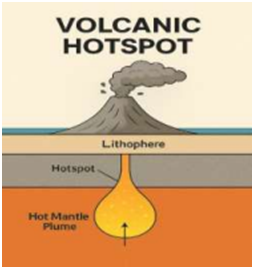Ethics Theory, TLP-UPSC Mains Answer Writing
Q. 3. What are volcanic hotspots? How do they differ from plate boundary volcanism? Illustrate with suitable examples. (150 words, 10 marks)
Introduction
Volcanic hotspots are isolated zones of volcanic activity caused by rising plumes of hot mantle material, unrelated to tectonic plate boundaries. They differ from boundary volcanism in origin, location, and geological structure.
Body
Features of Volcanic Hotspots
- Intraplate Occurrence: Hotspots occur within tectonic plates, far from active plate boundaries. Example: Hawaiian Islandsformed in the middle of the Pacific Plate.
- Mantle Plume Source: Caused by deep-seated thermal plumes that melt the crust from below. Example: Yellowstone hotspot beneath the North American Plate.
- Stationary Heat Source: The hotspot remains fixed while the tectonic plate moves over it, forming linear volcanic chains. Example: Emperor Seamount–Hawaiian Chain.
- Basaltic and Effusive Volcanism: Typically produces shield volcanoes with low-viscosity basaltic lava. Example: Mauna Loa in Hawaii.
Differences Between Hotspot and Plate Boundary Volcanism
| Aspect Hotspot Volcanism Plate Boundary Volcanism | ||
| Location | Occurs within tectonic plates (intraplate) | Occurs along plate boundaries (divergent or convergent) |
| Cause | Caused by rising mantle plumes | Caused by subduction, sea-floor spreading, or rifting |
| Distribution | Forms linear chains as the plate moves over a stationary hotspot | Forms volcanic arcs or mid-ocean ridges |
| Volcano Type | Generally produces shield
volcanoes with effusive basaltic eruptions |
Typically forms stratovolcanoes with explosive silica-rich magma |
| Tectonic
Interaction |
Independent of plate interaction | Directly involves interaction of two or more tectonic plates |

Conclusion













